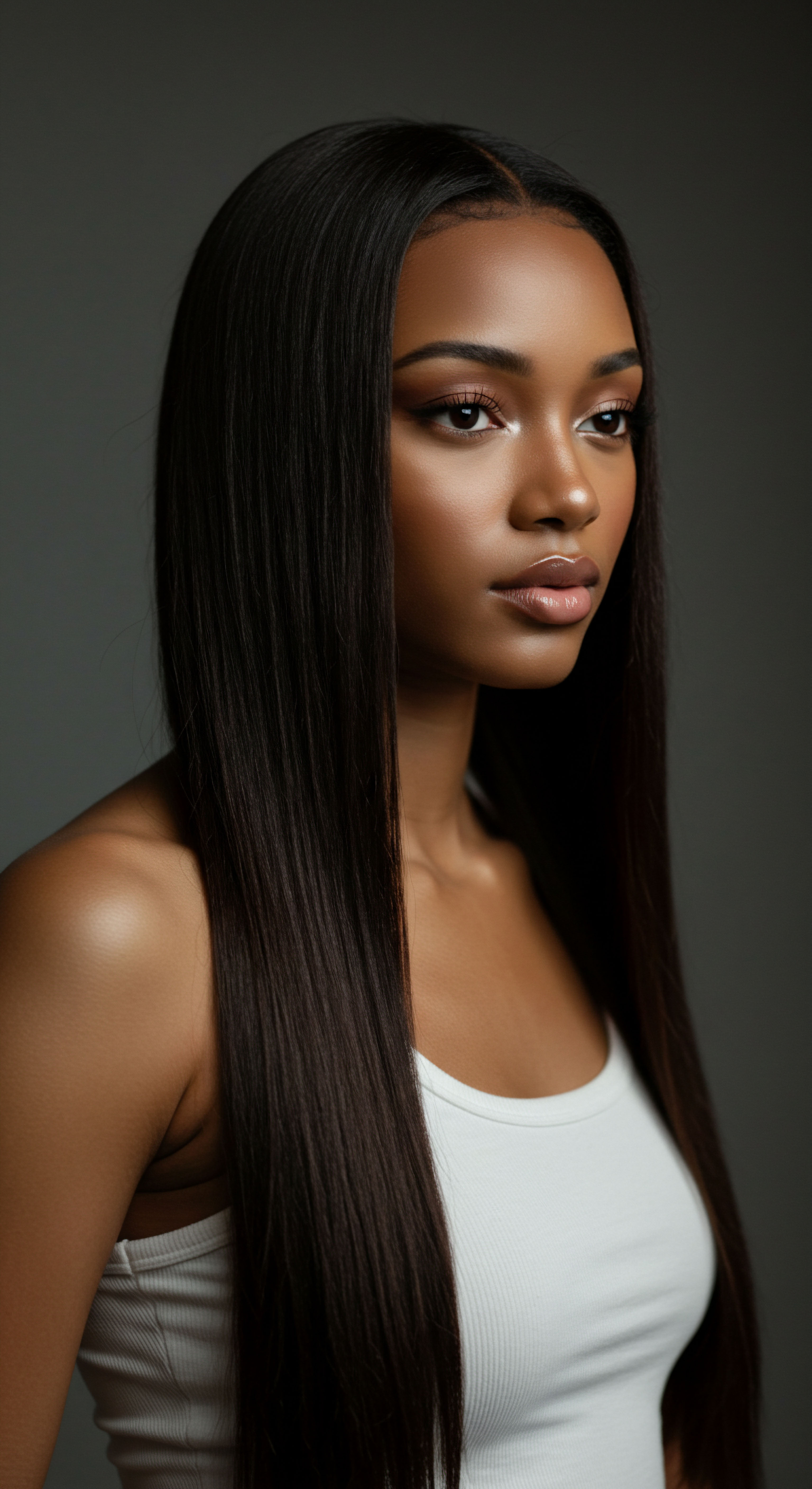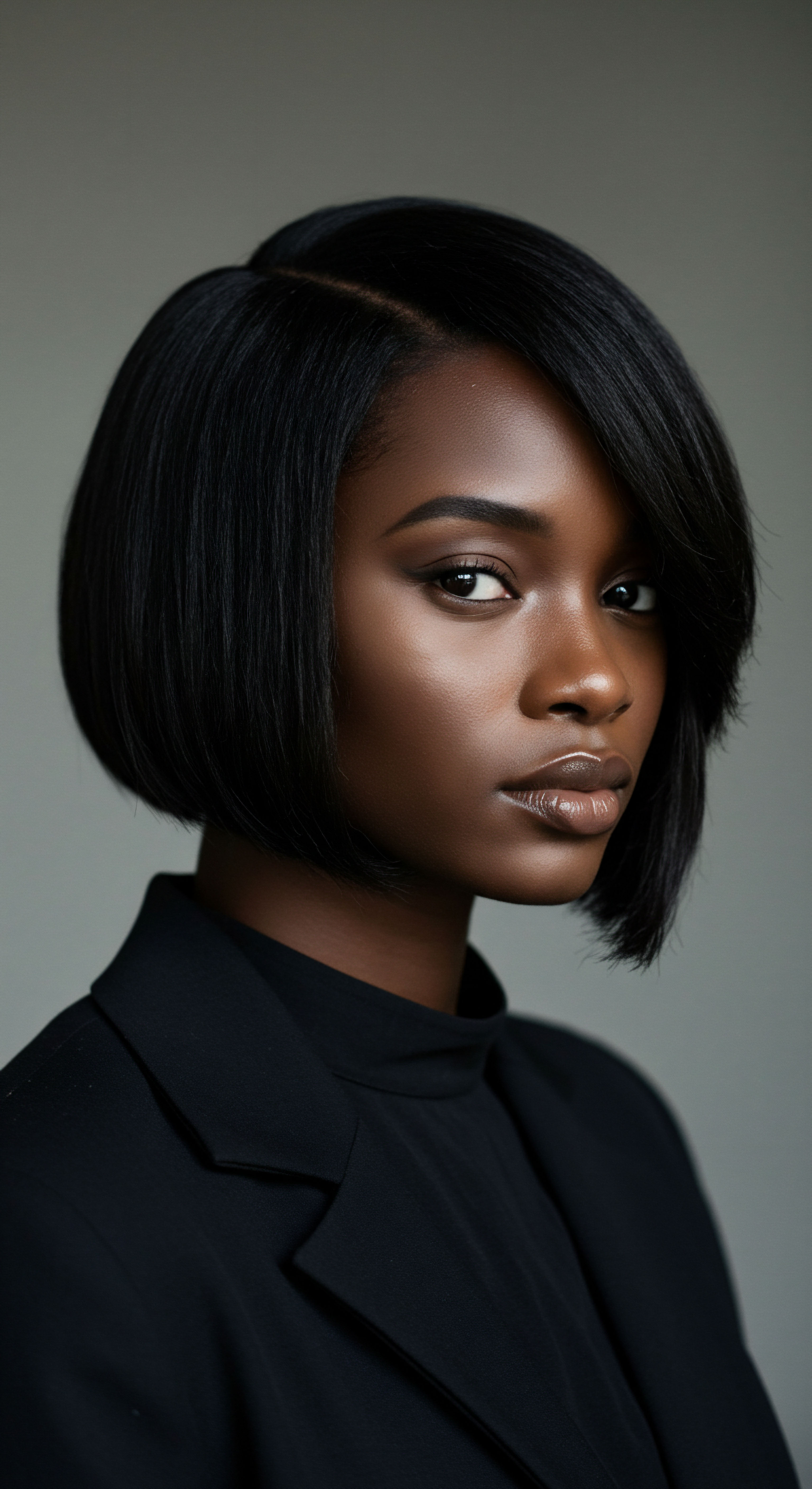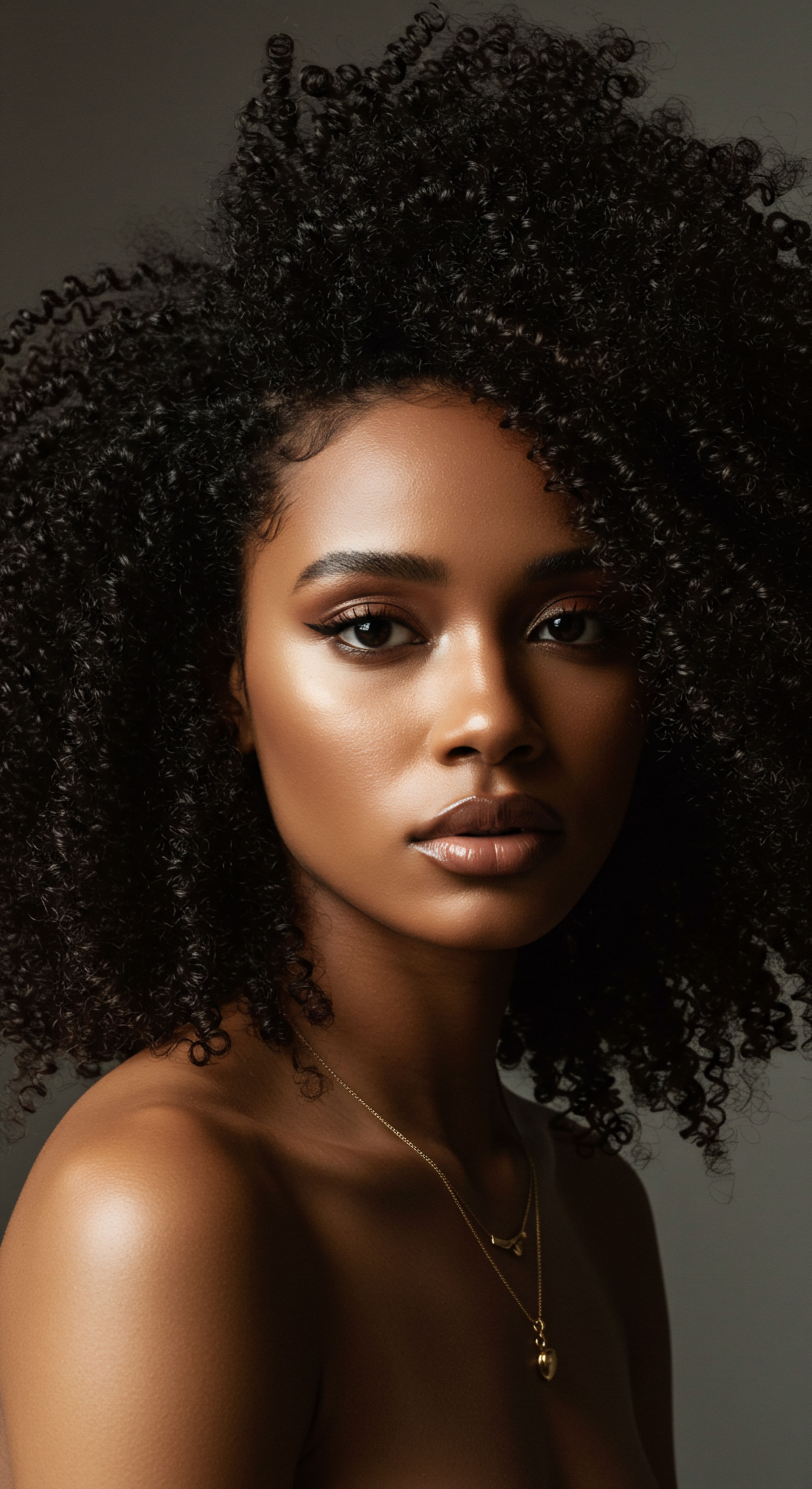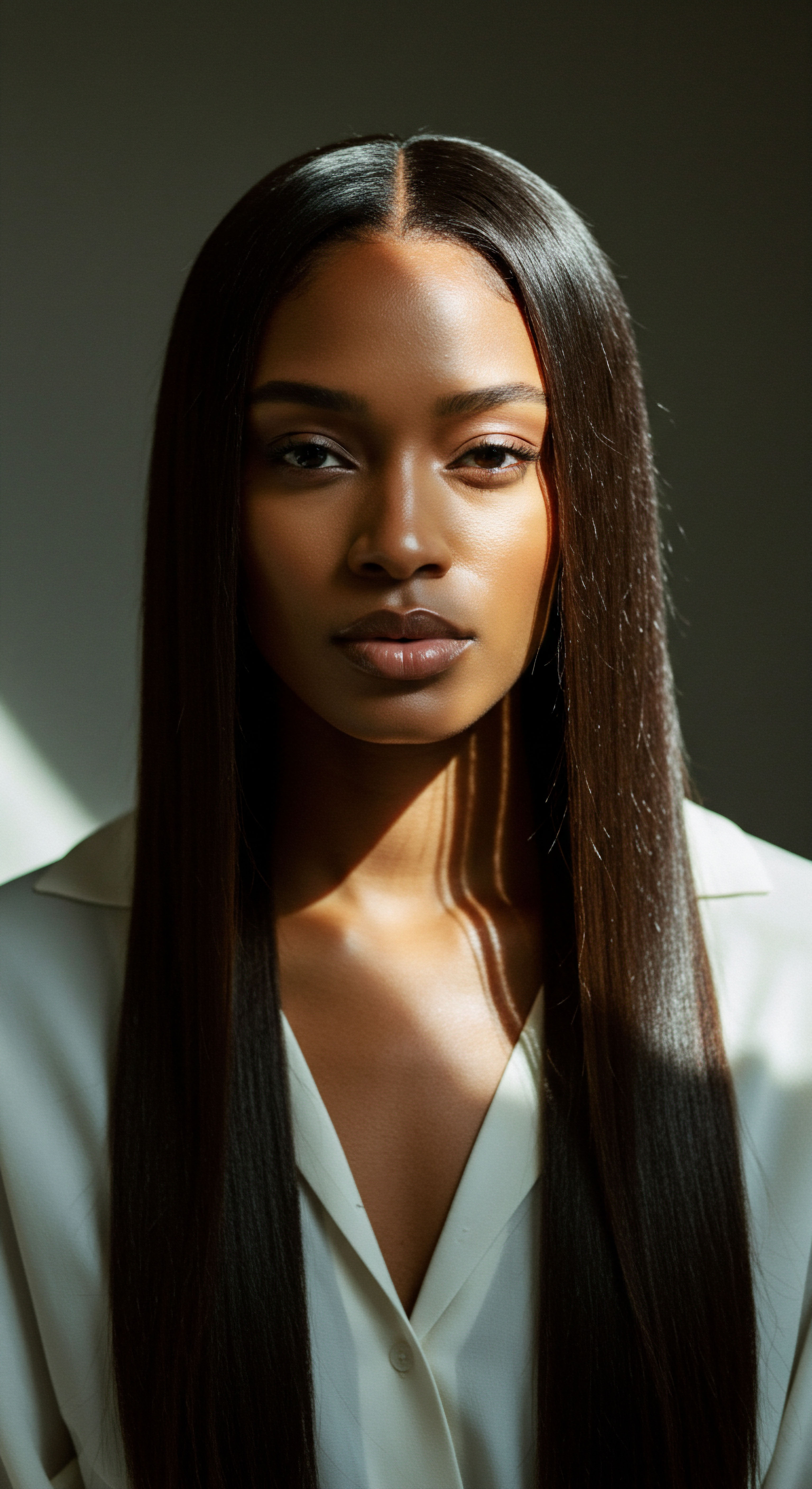
Roots
The whisper of the wind carries more than just a passing breeze; it often bears unseen particles, silent passengers in the air we breathe. For those with textured hair, this aerial dance holds a particular significance, inviting contemplation on how these environmental compounds might interact with the very structure of our strands. It prompts a quiet inquiry into the foundational understanding of our hair’s inherent architecture and its relationship with the world beyond our immediate touch. Roothea approaches this inquiry with a gentle curiosity, recognizing that to truly comprehend the nuances of external influences, we must first look within, to the very building blocks of our hair.
Our hair, far from a simple strand, presents a complex biological system. Each individual fiber, whether tightly coiled, loosely waved, or beautifully kinked, consists of distinct layers, each playing a role in its overall resilience and responsiveness to its surroundings. The outermost layer, the Cuticle, serves as the primary shield. Imagine it as a series of overlapping scales, much like shingles on a roof, designed to protect the inner cortex.
The orientation and integrity of these scales directly influence how hair interacts with moisture, products, and indeed, airborne elements. Beneath this protective outer casing lies the Cortex, which gives hair its strength, elasticity, and color, holding the very identity of our strands. The innermost core, the Medulla, a soft, sometimes absent central canal, plays a lesser-understood role but contributes to the hair’s overall diameter.
Hair’s intricate layers, from the protective cuticle to the resilient cortex, shape its interaction with the external world.

Hair Anatomy and Environmental Interaction
The unique helical structure of textured hair, characterized by its elliptical cross-section and often pronounced curvature, inherently exposes more surface area compared to straighter hair types. This increased surface presents a greater potential for environmental compounds to make contact and adhere. When air circulates, it carries with it a myriad of particles ❉ dust, soot, pollutants from vehicle emissions, industrial output, and even microscopic biological fragments. These airborne elements, varying in size and chemical composition, can settle upon the hair’s surface.
The mechanisms of adherence are manifold. Electrostatic forces, akin to the static cling experienced on a dry day, can draw negatively charged hair fibers to positively charged airborne particles. Furthermore, the natural oils, or Sebum, produced by the scalp and distributed along the hair shaft, can act as a sticky substrate, effectively trapping particulate matter. The microscopic irregularities and lifted cuticle scales, more common in textured hair due to its structural characteristics and propensity for dryness, offer additional anchor points for these compounds to lodge themselves.

How Particulate Matter Attaches to Hair
Particulate matter (PM) comprises tiny solid or liquid particles suspended in the air. These can range from coarse particles (PM10, with a diameter of 10 micrometers or less) to fine particles (PM2.5, 2.5 micrometers or less). The smaller the particle, the deeper it can penetrate and the more easily it can settle on surfaces, including hair.
Research indicates that the deposition of PM on hair surfaces is influenced by exposure time and the presence of sebum. The hair’s inherent electrical charge also plays a role; positively charged particles, for example, demonstrate a stronger affinity for healthy hair surfaces due to electrostatic attraction.
Consider the daily exposure ❉ a stroll through an urban setting, the lingering scent of a campfire, or simply the dust motes dancing in a sunbeam within our homes. Each instance presents an opportunity for these unseen environmental components to find a resting place on our hair. The implications extend beyond mere surface accumulation; these compounds can potentially alter the hair’s feel, appearance, and even its underlying health over time.

Textured Hair Classification Systems and Environmental Considerations
Understanding textured hair often involves referring to classification systems, such as the widely recognized curl pattern types (2a-4c). While these systems primarily categorize hair based on its curl shape, they indirectly speak to structural differences that influence environmental interaction. Hair with tighter curls (e.g. 4a, 4b, 4c) tends to have more bends and twists along its length.
This curvilinear path means that the cuticle layers are not always flat and smooth against the hair shaft, making them more prone to lifting. When cuticles are raised, the hair becomes more porous, offering additional sites for environmental compounds to cling to and potentially absorb into.
The dryness often associated with textured hair, a result of the natural oils struggling to travel down the hair shaft’s intricate coils, further compounds this susceptibility. Dry hair can be more prone to static, attracting airborne particles. It also possesses a higher capacity for absorption, meaning that once a compound settles, it might be more readily drawn into the hair fiber itself.
| Environmental Compound Type Particulate Matter (PM) |
| Description Dust, soot, smoke, industrial emissions |
| Potential Interaction with Hair Adheres to surface, dulls appearance, can cause physical damage to cuticle. |
| Environmental Compound Type Volatile Organic Compounds (VOCs) |
| Description Gases from vehicles, household products, industry |
| Potential Interaction with Hair Can cause oxidative stress, alter sebum production. |
| Environmental Compound Type Heavy Metals |
| Description Lead, mercury, cadmium, arsenic |
| Potential Interaction with Hair Accumulates on scalp and hair, linked to various hair issues. |
| Environmental Compound Type UV Radiation |
| Description Sunlight (UVA, UVB) |
| Potential Interaction with Hair Degrades hair structure, weakens proteins, causes color change, exacerbates pollution damage. |
| Environmental Compound Type Allergens |
| Description Pollen, mold spores |
| Potential Interaction with Hair Can cause scalp irritation, itching, and inflammation. |
This foundational understanding allows us to appreciate the delicate balance required to maintain textured hair’s vitality in an environment increasingly filled with potential aggressors. The hair’s architecture, its inherent moisture profile, and the external elements all play a part in a continuous conversation.

Ritual
Stepping from the quiet contemplation of hair’s foundational nature, we now turn our attention to the rhythms of daily life, to the practical wisdom that guides our hands in caring for textured strands. The question of whether environmental compounds settle on textured hair naturally leads us to consider how our routines, our deliberate choices, can respond to this interaction. This section offers gentle guidance through the practices that shape our hair’s resilience, inviting a shared exploration of techniques and methods with a sense of purposeful care. It is a space where the science of hair meets the art of living with it, finding harmony in purposeful ritual.

Cleansing Practices for Environmental Compounds
The accumulation of environmental compounds on textured hair necessitates thoughtful cleansing. Unlike straight hair, which allows sebum and debris to slide down more easily, the coils and kinks of textured hair can trap particles, leading to buildup. This buildup, if left unattended, can dull the hair’s natural luster, contribute to dryness, and even irritate the scalp.
A crucial aspect of managing environmental residue involves selecting appropriate cleansing agents. Harsh sulfates, while effective at stripping away dirt and oil, can also strip the hair of its much-needed natural moisture, leaving it vulnerable and prone to breakage. For textured hair, which often leans towards dryness, this can be counterproductive. Instead, opting for gentler, sulfate-free cleansers that still possess the ability to lift and remove environmental debris without compromising the hair’s delicate moisture balance becomes paramount.
Regular cleansing is a simple yet profound act. The frequency, however, is deeply personal and depends on individual lifestyle, environmental exposure, and hair’s specific needs. For those living in areas with high air pollution, more frequent washing may be beneficial.
Conversely, those with very dry hair or minimal exposure might benefit from less frequent, yet thorough, cleansing sessions. The goal remains consistent ❉ to remove external aggressors while preserving the hair’s integrity.
Thoughtful cleansing, using gentle products, is essential for removing environmental buildup while preserving hair’s natural moisture.

Product Selection for Environmental Defense
Beyond cleansing, the products we choose play a significant role in creating a protective shield against environmental elements. Conditioners, leave-in treatments, and styling products can form a physical barrier on the hair shaft, reducing the direct adherence of particulate matter. Ingredients such as silicones (used judiciously to avoid excessive buildup), natural oils, and butters can coat the cuticle, smoothing its surface and making it less hospitable for pollutants to cling.
- Film-Forming Humectants ❉ Ingredients like aloe vera and flaxseed gel create a protective barrier, managing moisture intake and helping to seal the cuticle, which can reduce the adherence of pollutants.
- Antioxidant-Rich Treatments ❉ Products containing vitamin C or grape seed extract can help combat the oxidative stress caused by pollutants and UV radiation.
- Chelating Agents ❉ These ingredients, such as disodium EDTA, bind with metal ions in water and can also help remove heavy metals that may have settled on the hair.
The application technique also holds weight. Ensuring products are evenly distributed from root to tip provides a more uniform protective layer. For textured hair, which can be prone to tangles, applying products section by section ensures every strand receives attention, minimizing areas where compounds might settle undisturbed.

Protective Styling as a Shield
Styling choices extend beyond aesthetics; they serve as a practical defense against environmental exposure. Styles that tuck away the ends of the hair, such as braids, twists, or buns, reduce the hair’s exposed surface area. This physical containment limits direct contact with airborne particles and UV radiation. Head coverings, like scarves or bonnets, offer an additional layer of protection, particularly when outdoors in polluted environments.
The historical context of protective styling in various cultures, particularly within Black and mixed-race communities, reveals a deep-seated wisdom that intuitively understood the need to safeguard hair from the elements. These traditions, passed down through generations, often served practical purposes, protecting hair from sun, dust, and environmental wear, alongside their social and artistic significance.
While styling, it is wise to avoid overly sticky or heavy products that can attract and trap more particulate matter. Lightweight, water-based formulas that seal the cuticle without creating a tacky surface are often preferred. The choice of styling tools also matters; minimizing heat styling helps preserve the cuticle’s integrity, making it a stronger barrier against environmental aggressors.

Relay
Having explored the fundamental nature of hair and the practicalities of daily care, we now step into a deeper consideration of the intricate interplay between textured hair and its environment. This section invites us to look beyond the surface, to the less apparent complexities where science, cultural practices, and contemporary challenges converge. We will examine the subtle mechanisms by which environmental compounds interact with textured hair, consider the long-term ramifications, and draw upon research that sheds light on these often-overlooked connections. This exploration seeks to offer profound insights, moving beyond simple observation to a more comprehensive understanding of our hair’s lived experience in the world.

The Microscopic Dance of Deposition and Adsorption
The question of whether environmental compounds settle on textured hair is not merely a matter of visible dust. It involves a sophisticated interplay of forces at the microscopic level. Hair, particularly textured hair, possesses a unique surface topography.
The scales of the cuticle, though designed to lay flat, often present slight elevations or gaps due to the hair’s natural bends and twists, or from routine manipulation and styling. These irregularities serve as potential micro-pockets where airborne particles can lodge.
Adsorption, a process where molecules adhere to a surface, plays a central role. Hair keratin, the primary protein component of hair, contains sulfur-rich amino acids, particularly cysteine. These amino acids possess sulfhydryl groups that can interact with various environmental contaminants, including heavy metals. The negatively charged surface of hair, a result of its protein structure, can also attract positively charged ions present in pollutants.
A study published in the Polish Journal of Environmental Studies highlights the utility of Human Hair as a Bioindicator for environmental exposure. Research on workers near a steel factory demonstrated that hair samples showed significantly higher content of heavy metals, such as iron, copper, manganese, nickel, chromium, zinc, arsenic, lead, and cobalt, compared to control groups in rural areas. A direct correlation was found between the concentration of dust in the environment and the heavy metals present in scalp hair, with longer working years correlating to higher metal values. This underscores hair’s capacity to accumulate environmental contaminants from its surroundings, making it a record keeper of our atmospheric encounters.

Does Hair Porosity Affect Environmental Compound Absorption?
Hair porosity, referring to the hair’s ability to absorb and retain moisture, is a significant factor in its interaction with environmental compounds. Textured hair, especially those with tighter curl patterns, often exhibits higher porosity due to the natural lifting of cuticle scales. When the cuticle is raised or damaged, the hair shaft becomes more open, allowing substances to enter more readily. This increased openness can facilitate the absorption of environmental compounds beyond mere surface adherence.
For instance, a study examining the effects of ultraviolet rays and particulate matter on hair porosity in damaged hair revealed that while particulate matter alone did not cause hair porosity, its combination with UV radiation substantially increased it. This suggests a synergistic effect where one environmental stressor (UV) can compromise the hair’s barrier, making it more susceptible to the effects of another (particulate matter). When the cuticle is compromised, whether by chemical treatments, heat, or environmental stressors, the hair becomes more vulnerable to external aggressors.
The internal structure of the hair, the cortex, can then become exposed to these compounds, potentially leading to oxidative stress and degradation of hair proteins. This internal damage can manifest as reduced strength, elasticity, and altered color.

Cultural Perspectives on Environmental Hair Care
Beyond scientific mechanisms, cultural practices across various communities, particularly those with a heritage of textured hair care, offer profound insights into mitigating environmental impacts. For generations, traditional practices have centered on protective styling, the use of natural emollients, and gentle cleansing methods. These practices were not merely aesthetic; they were often born from an intuitive understanding of hair’s needs in specific environmental contexts.
In many African and diasporic cultures, hair has historically been a symbol of identity, status, and spirituality. The elaborate styling techniques, often involving braids, twists, and coverings, served to protect the hair from sun, dust, and harsh climates. The use of natural butters and oils, like shea butter or coconut oil, not only provided moisture but also created a physical barrier against external elements, minimizing the adherence of particulate matter and pollutants. This cultural wisdom, passed down through generations, implicitly addressed the very challenge of environmental compounds settling on hair, long before modern scientific terminology emerged.
The resilience and adaptability embedded in these traditions underscore a deep respect for hair as a living extension of self, worthy of deliberate care and protection from the elements. This perspective encourages us to view hair care not as a chore, but as a ritual of preservation and celebration.

Long-Term Ramifications and Bio-Monitoring
The continuous exposure to environmental compounds can lead to a cascade of effects on textured hair over time. Accumulation of pollutants can contribute to dullness, dryness, and a rough texture. Heavy metals, for example, can alter the hair’s protein structure and even influence its color. Prolonged exposure to particulate matter can lead to oxidative stress on the scalp and hair follicles, potentially impacting hair growth and even contributing to hair loss.
The analysis of human hair has emerged as a valuable tool for biomonitoring environmental exposure. Hair acts as a biological record, accumulating elements and compounds from both internal (bloodstream) and external (direct deposition) sources over time. This makes hair a unique matrix for assessing long-term exposure to certain pollutants, providing insights that blood or urine samples might miss due to their shorter monitoring windows.
While hair analysis offers a compelling avenue for understanding exposure, its interpretation requires careful consideration of various factors, including hair care practices and cosmetic treatments, which can influence the retention of contaminants. Nonetheless, the growing body of research confirms hair’s role as a silent witness to our environmental interactions, particularly for those with hair structures that present a larger surface area and higher potential for adherence.
The awareness of these long-term ramifications strengthens the argument for proactive and informed hair care strategies, moving beyond superficial concerns to address the deeper health and vitality of textured hair in an ever-changing environment.

Reflection
As we close this exploration into the interaction between textured hair and the environmental compounds that seek to settle upon it, we find ourselves with a richer appreciation for the resilience and complexity of our strands. The delicate balance between hair’s intrinsic design and the external world invites us to view our care routines not as mere acts of maintenance, but as conscious expressions of reverence for our heritage and our health. The whispers of science and the echoes of ancestral wisdom converge, reminding us that understanding our hair is a continuous unveiling, a gentle unfolding of knowledge that empowers us to nurture our unique beauty with informed intention.

References
- Zviak, C. (1986). The Science of Hair Care (1st ed.). CRC Press.
- Davis-Sivasothy, A. (2011). The Science of Black Hair ❉ A Comprehensive Guide to Textured Hair Care.
- Evans, T. & Wickett, R.R. (Eds.) (2012). Practical Modern Hair Science. Allured Business Media.
- Adams McGhee, A. (2015). Definitive Trichology’s Complete Guide to Healthy, Beautiful Hair.
- Gavazzoni Dias, M. F. (2015). Hair Cosmetics ❉ An Overview. International Journal of Trichology, 7(1), 2.
- Rathi, S. & D’Souza, P. (2015). Shampoo and Conditioners ❉ What a Dermatologist Should Know? Indian Journal of Dermatology, 60(3), 248.
- Chojnacka, K. Saeid, A. Michalak, I. & Mikulewicz, M. (2012). Effects of Local Industry on Heavy Metals Content in Human Hair. Polish Journal of Environmental Studies, 21(6), 1563-1570.
- Yang, S. J. & Yu, H. J. (2024). Effects of Ultraviolet Rays and Particulate Matter on Hair Porosity in Damaged Hair. Journal of Cosmetic Dermatology.
- Bencko, V. (1995). Use of human hair as a biomarker in the assessment of exposure to pollutants in occupational and environmental settings. Toxicology, 101(1-2), 29-39.
- Zheng, J. et al. (2023). Human hair as a noninvasive matrix to assess exposure to micro-organic contaminants. Science of the Total Environment, 892, 164341.